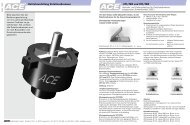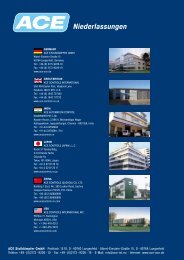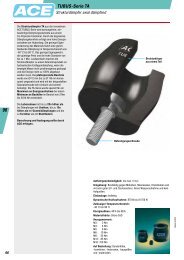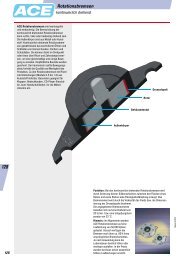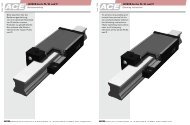Industrial Gas Springs - ACE Controls International
Industrial Gas Springs - ACE Controls International
Industrial Gas Springs - ACE Controls International
Create successful ePaper yourself
Turn your PDF publications into a flip-book with our unique Google optimized e-Paper software.
164<br />
164<br />
Calculation<br />
To obtain the ideal selection to give the<br />
optimum operation for a gas spring it is<br />
important to identify the following points:<br />
• gas spring size<br />
• required gas spring stroke<br />
• mounting points on flap and frame<br />
• extended length of the gas spring<br />
• required extension force<br />
• hand forces throughout the complete<br />
movement on the flap<br />
With our free calculation service you can<br />
eliminate the time-consuming calculation and<br />
send us your details by fax or e-mail. Just<br />
complete the information shown on the calculation<br />
formulae page number 165. Please<br />
attach a sketch of your application (a simple<br />
hand sketch is sufficient) in side view. Our<br />
application engineers will determine the<br />
optimum gas springs and mounting points and<br />
calculate the ideal situation to satisfy your<br />
requirements.<br />
You will receive a quotation showing the opening and closing forces and<br />
our recommended mounting points to suit your application.<br />
Safety Instructions<br />
<strong>Industrial</strong> <strong>Gas</strong> <strong>Springs</strong><br />
Calculation and Safety Instructions<br />
<strong>Gas</strong> springs are filled with pure nitrogen gas. Nitrogen is an inert gas<br />
that does not burn or explode and is not poisonous.<br />
Please note!: the internal pressure of gas springs can be up to<br />
300 bar. Do not attempt to open or modify them.<br />
<strong>ACE</strong> gas springs will operate in surrounding temperatures from -20 °C<br />
to +80 °C. We can equip our springs with special seals to withstand<br />
temperatures as low as -45 °C or as high as +200 °C. <strong>Gas</strong> springs should<br />
not be placed over heat or in open fire!<br />
Disposal/Recycling: <strong>Gas</strong> <strong>Springs</strong> consist mostly of metal and the<br />
metal could be recycled, but first the gas pressure must be removed.<br />
Please ask for our disposal recommendations which advise how to<br />
depressurize the gas springs and make them safe to recycle.<br />
All gas springs are marked with the part number, the production date<br />
and a warning sign “Do not open high pressure”. We are not responsible<br />
for any damages of any kind that arises due to goods that are not<br />
marked accordingly.<br />
<strong>Gas</strong> springs should be installed with the piston rod downwards. This<br />
position ensures best damping quality. Only <strong>ACE</strong> gas springs include<br />
an integrated grease chamber which allows for alternative<br />
mounting opportunities.<br />
“Calculation offer<br />
with all required details<br />
for assembly!”<br />
<strong>Gas</strong> springs should not be exposed to tilting or side load forces during<br />
operation or whilst static (this can cause bending of the piston rod or<br />
early wear).<br />
<strong>Gas</strong> springs are maintenance-free. Do not grease or oil the piston<br />
rod.<br />
The piston rod must not be painted and should be protected against<br />
shocks, scratches and dirt. The cylinder should not be deformed as such<br />
damage would destroy the sealing system.<br />
<strong>ACE</strong> gas springs can be stored in any position. Pressure lost through<br />
long storage is not to be expected. There are no known negative values,<br />
but there may be a sticking effect the first time you compress a spring.<br />
This may require a higher initial force to operate the gas spring for the<br />
first time (initial breakaway force).<br />
The tolerance for the installation length is generally deemed to be<br />
± 2 mm. If very high demands are placed on durability and stability,<br />
please avoid the combination of small diameter + long stroke + high<br />
force.<br />
The filling tolerance is -20 N to 40 N or 5% to 7%.<br />
Stoßdämpfer GmbH · PO Box 1510 · D-40740 Langenfeld · Tel. +49-2173-9226-4100 · Fax +49-2173-9226-89 · E-Mail: info@ace-int.eu<br />
Issue 6.2011 Specifications subject to change



